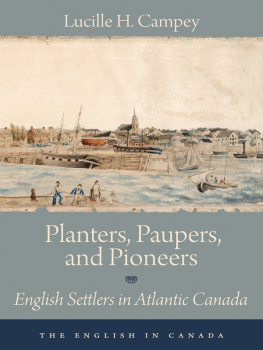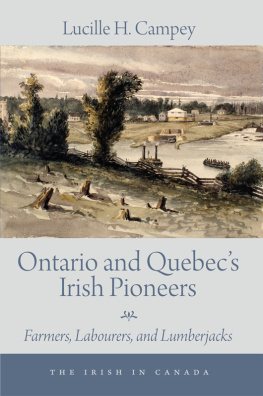Edwin C. Guillet - Pioneer Settlements in Upper Canada
Here you can read online Edwin C. Guillet - Pioneer Settlements in Upper Canada full text of the book (entire story) in english for free. Download pdf and epub, get meaning, cover and reviews about this ebook. year: 1969, publisher: University of Toronto Press, genre: Home and family. Description of the work, (preface) as well as reviews are available. Best literature library LitArk.com created for fans of good reading and offers a wide selection of genres:
Romance novel
Science fiction
Adventure
Detective
Science
History
Home and family
Prose
Art
Politics
Computer
Non-fiction
Religion
Business
Children
Humor
Choose a favorite category and find really read worthwhile books. Enjoy immersion in the world of imagination, feel the emotions of the characters or learn something new for yourself, make an fascinating discovery.

- Book:Pioneer Settlements in Upper Canada
- Author:
- Publisher:University of Toronto Press
- Genre:
- Year:1969
- Rating:5 / 5
- Favourites:Add to favourites
- Your mark:
- 100
- 1
- 2
- 3
- 4
- 5
Pioneer Settlements in Upper Canada: summary, description and annotation
We offer to read an annotation, description, summary or preface (depends on what the author of the book "Pioneer Settlements in Upper Canada" wrote himself). If you haven't found the necessary information about the book — write in the comments, we will try to find it.
Informative, accurate and delightfully readable, this volume brings to life the pioneers of Ontario and vividly recreates their experiences.
Pioneer Settlements in Upper Canada — read online for free the complete book (whole text) full work
Below is the text of the book, divided by pages. System saving the place of the last page read, allows you to conveniently read the book "Pioneer Settlements in Upper Canada" online for free, without having to search again every time where you left off. Put a bookmark, and you can go to the page where you finished reading at any time.
Font size:
Interval:
Bookmark:
PIONEER SETTLEMENTS IN UPPER CANADA
Edwin C. Guillet

Copyright, Canada, 1933
by
Edwin C. Guillet
Reprinted 1969 by University of Toronto Press
This volume contains Section II
of Early Life in Upper Canada, Settlement
ISBN 8020-3102-1 (cloth)
ISBN 8020-6110-9 (paper)
T HE G LENGARRY H IGHLANDERS
I beg to state that the County of Glengarry has on every occasion been distinguished for good conduct, and will on any emergency turn out more fighting men in proportion to its population than any other in Her Majestys dominions.
B ETWEEN 1750 and the outbreak of the American Revolution a large number of families from the Highlands of Scotland emigrated to New York State where they settled in the Mohawk Valley near Johnstown, the home of Sir William Johnson. Many of these Highlanders were Jacobites, whose previous activities are thus summarised by the historian of Glengarry:
Conspicuous among the Jacobites were the people of Glengarry. With other Scottish Cavaliers, they had rallied around Montrose, and throughout his campaigns were one of the mainsprings which kept up the astonishing movements of the chivalrous enterprise; they were foremost among the Highland forces under John Graham of Claver-house, the Viscount of Dundee, and bore the brunt at Killiecrankie, when that great leader fell; in greater number than almost any other Highland Clan they joined the Earl of Mar in 1715.... In 1745 their leaders were the most trusted adherents of Prince Charles, and their men as brave as the bravest of his soldiers; they paid the penalty like men of valour as they were, some in death, others in expatriation, and all, from the proud Chief to the humblest of the clansmen, in the devastation of their homes.
They stood to the last, and when standing was oer,
All sullen and silent they dropped the claymore,
And yielded, indignant, their necks to the blow,
Their homes to the flame, and their lands to the foe.
The Highland emigration to the State of New York was caused largely by the distress in Scotland. Chieftains were no longer able to keep a large retinue of retainers, and dispossessed their tenants, turning their estates into sheep farms. Particularly during the Napoleonic Wars the Imperial Government prevented emigration, and many of those who attempted to leave the country were pressed into the army or navy; others wandered about in search of employment and food. The same causes led to the movement at the close of the eighteenth century and afterwards to settle Highlanders in Canada.
During the Revolutionary War most of the Scots in New York State remained staunch Loyalists, large numbers of them taking up arms against the rebels. As a result they were ill-treated during the last years of the struggle, and sought permission to come to Canada where they could remain under the British flag. As early as 1779 a petition of twenty-four families was forwarded to the British Government asking that some arrangement be effected to enable them to emigrate; and in succeeding years further memorials were sent. In his Reminiscences Alexander Macdonell stated that the first Highlanders in Upper Canada numbered about 300, the followers of an Irish priest named McKenna. By 1776 they had arrived at Orange (Albany), in New York State, and came to Canada some time later in order that they might enjoy the Roman Catholic religion without interference.
It was not, however, until the Revolutionary War was over, in 1783, that it was possible to disband the Kings Royal Regiment of New York (usually known as the Royal Yorkers), and the Royal Highland Emigrant Regiment. The officers and men of the First Battalion of the former unit, with their families, had been stationed at the close of the War at Isle aux Noix and Carleton Island; these Highlanders, 1,462 in number, settled in 1784 in the first five townships west of the Quebec boundaryLancaster, Charlottenburg, Cornwall, Osnabruck and Williamsburg. This regiment was Sir John Johnsons corps, and most of its members had been his dependents and retainers in the Mohawk Valley. Most of the Second Battalion of the same regiment settled farther west, in Lennox and Prince Edward Counties. Many men of the 84th, or Royal Highland Emigrant Regiment, also settled in Glengarry and vicinity. Williamstown was the centre of the settlement along the front of Glengarry, and New Johnstown (Cornwall), in Stormont, was the main government depot for the whole district; the latter village had a few inhabitants as early as 1776.
The approach of the Loyalists to the St. Lawrence was often made under difficulties which caused extreme hardship. Many men, women and children walked long distances through swamp and forest, suffering innumerable privations. An example of the experiences of these refugees is related by John MacLennan:
A man whom I knew as an useful member of the community was the subject of the following incident. His mother carried two young children on her back. In the weary journey through the woods she thought her burden had become lighter, and discovered that she had dropped one. On retracing her steps for some distance, she found the youngster quietly sleeping beside a decayed log over which she had passed, with hands begrimed with earth. He lived to an old age, well-known by the name of Spogan Dubh (black paws)the exclamation of his mother on finding him. One of the party, coming all the way from Georgia, told the story of the company feasting on a dog, to avoid starvationhis meagre share being a paw.
The last part of the Loyalists trek was in some cases slightly easier. Those who approached Canada by way of Lake Champlain were sometimes met by military bateaux, which transported them to the St. Lawrence via the Richelieu River. From Sorel they made the laborious and tedious trip up the St. Lawrence in similar open boats, and upon their arrival at New Johnstown they encamped in tents until the land which the government agent awarded them had been properly surveyed.
The generous land grants which were made to these soldier Loyalists were based upon the rank that each man had held in the army. Each private soldier received one hundred acres on the river front and two hundred acres remote; fifty acres were allowed in addition to his wife and to each child, while each son and daughter upon coming of age was to receive an additional two hundred acres. Officers grants were considerably larger, as much as five thousand acres being given to field officers. The settlement of Glengarry County was probably military to a greater extent than that of any other section of the province. Each township was assigned to a corps, the lots were then numbered and placed in a hat, and each soldier in turn drew his grant and went immediately to his future home. Occasionally some of the settlers afterwards exchanged lots in order that old comrades might be alongside one another. As in other parts of Upper Canada, Roman Catholics and Protestants were, as a general rule, located separately.
The government dealt generously with the Loyalists in respect to supplies as well as land. Most of them had had all their possessions in the United States confiscated, and came to their new home with little or nothing. That their sacrifices were appreciated by the Imperial Government was very apparent in the plans made for their reception in Canada. Difficulties of transportation, however, made it impossible to give the St. Lawrence Loyalists as much as was distributed to those in the Maritime Provinces. The latter settlers received lumber, bricks, ploughs and even church bells, but such things were not given to the Glengarry Highlanders. Hoes and spades had to be substituted for ploughs in almost every case, and each settler had to obtain most of his building material from the forests.
Next pageFont size:
Interval:
Bookmark:
Similar books «Pioneer Settlements in Upper Canada»
Look at similar books to Pioneer Settlements in Upper Canada. We have selected literature similar in name and meaning in the hope of providing readers with more options to find new, interesting, not yet read works.
Discussion, reviews of the book Pioneer Settlements in Upper Canada and just readers' own opinions. Leave your comments, write what you think about the work, its meaning or the main characters. Specify what exactly you liked and what you didn't like, and why you think so.


